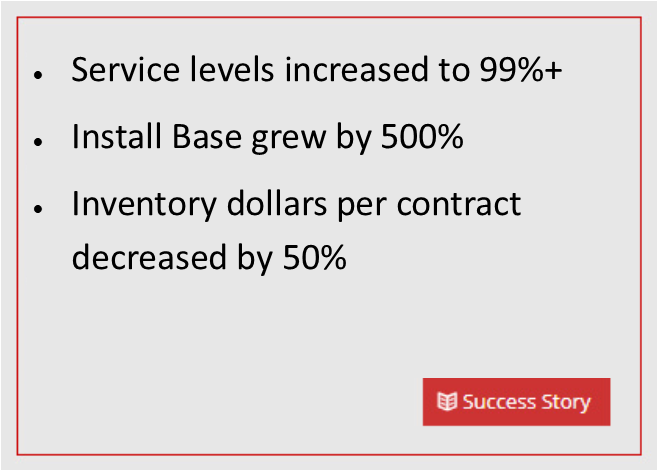Inventory Forecasting through Planning Analytics with Prophet Software
Inventory planning fraught with challenges, but spare parts inventory management presents a unique opportunity to reduce costs while increasing customer satisfaction. Service supply chain organizations must deal with challenges related to purchase, repair, replenishment, redeployment, part chaining, customer install base, entitlements, and more. The real world is an imperfect world, and because of that, an added challenge facing all service parts planning teams is the need to truly understand the calculated part fulfillment rate versus the actual part execution rate.
Examples of this imperfection include: service bills of material that are incomplete, customer contract data that is fragmented, part master updates that may not happen in a timely manner, and supplier order lead-times that are missed. Another key issue in supply planning and execution is the lack of coordination between these systems. Each of these real world issues impact the ability of the planning organization to accurately predict the inventory required in each inventory location to meet its expected customer service level target. Service organizations bound to contractual obligations of rapid-response Service Level Agreements (SLAs) with penalties often spend significant time and money doing extraordinary tasks in expediting and transportation to meet the customer SLA. So while the customer is happy, the inventory planning team did not meet the planning SLA of part availability and ultimately cost the company money. It becomes important then to not only deliver on the service promise, but to do so efficiently.
However, what if there was an automated way to analyze every part demand to determine if the material needed was available (a “hit”) or was not available (a “miss”) in the optimal location at the time a customer demand occurred? And what if there was an automated way to determine the root cause of each “miss” so that corrective action could be taken?
Planning Analytics is the process of evaluating and revising your stocking plan so that it becomes as efficient as possible, reducing misses and expedited transportation costs. Successful service supply chain organizations will not only meet customer expectations while optimizing inventory, but they will use planning analytics to assess and measure the plan in pursuit of continuous improvement.
Find out for yourself how Baxter can optimize your service supply chain inventory.
Complete this form and we’ll get in contact with you or email us at info@baxterplanning.com / call us at +1 (512) 323 5959 .
Service Supply Chain Planning Excellence through Planning Analytics with Inventory Forecasting Software
Prophet by Baxter is a software as a service (SaaS) focused on field service inventory planning and execution to optimize service parts management operations. Prophet’s Planning Analytics capabilities measures actual service level in the most strict and correct way for a service parts planning organization: was the part available in the location from which each customer order should have been filled at the time the demand occurred? In other words: did you have the right part, in the right place, at the right time?
Prophet Hit Rate measures how well your company is executing to your target service level by evaluating each demand request to determine if it should be considered a Hit or Miss. If the demand was filled by a location other than the planned site, it is still considered to be a planning miss. Even if a Service Level Agreement can be met from another location, those transactions can incur additional transportation and processing costs. Summary level reporting graphically shows monthly hit rates and the root causes of any misses, making it easy for planners to analyze trends and performance over time. Detailed level reporting provides granular information about each demand request, its hit or miss classification, and the root cause of any misses for in-depth analysis. Prophet distinguishes over 25 miss root cause classifications for lack of part availability to simplify the identification of:
- Data quality issues: The part was unavailable because data provided to the planning system didn’t indicate there was a possibility for demand at that location. An example of this is inaccurate Bills of Material master data records or missing/incorrect installed base data.
- Service execution issues: The part was unavailable despite being accounted for in the plan. An example of this is a late supplier delivery causing a network inventory shortage.
- Planning issues: The part was unavailable due to a decision to restrict availability and may warrant a reevaluation of the plan.
Baxter provides thorough documentation of corrective actions for each miss root cause category to drive continuous improvement. Prophet’s Hit Rate and associated miss root cause corrective actions highlight issues for review, prioritization, and management, with the ultimate goal of aligning the measured service level with the theoretical service level.
Planning Analytics Expertise with Baxter
Baxter has leveraged decades of service parts planning experience to design, identify, and measure 30 critical service supply chain Best Practice categories during each client’s business review process. These criteria are standardized in a Best Practice Scorecard and provide a foundation to deliver on our commitment to helping customers optimize and automate their service supply chains. The scorecard is organized by practice area and the benchmarks for the Planning Analytics practice area measure the customer’s mastery of the Hit Rate best practice to match root causes to operational issues.
During implementation, planners are provided with training to understand how Hit Rate is measured and why it is important to your organization in driving reduction of both expedited transportation and downtime costs. For customers that are looking for additional support, Baxter’s Planning as a Service offering can provide an extension to your planning organization to perform these responsibilities. Your designated Baxter planners will perform a range of tactical and strategic initiatives including a monthly review and analysis the Hit Rate report.


